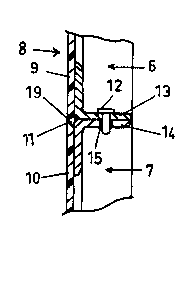Some of the information on this Web page has been provided by external sources. The Government of Canada is not responsible for the accuracy, reliability or currency of the information supplied by external sources. Users wishing to rely upon this information should consult directly with the source of the information. Content provided by external sources is not subject to official languages, privacy and accessibility requirements.
Any discrepancies in the text and image of the Claims and Abstract are due to differing posting times. Text of the Claims and Abstract are posted:
| (12) Patent Application: | (11) CA 2182892 |
|---|---|
| (54) English Title: | CONTAINER SIDE |
| (54) French Title: | PAROI LATERALE DE RECIPIENT |
| Status: | Deemed Abandoned and Beyond the Period of Reinstatement - Pending Response to Notice of Disregarded Communication |
| (51) International Patent Classification (IPC): |
|
|---|---|
| (72) Inventors : |
|
| (73) Owners : |
|
| (71) Applicants : |
|
| (74) Agent: | SMART & BIGGAR LP |
| (74) Associate agent: | |
| (45) Issued: | |
| (86) PCT Filing Date: | 1995-12-13 |
| (87) Open to Public Inspection: | 1996-06-20 |
| Availability of licence: | N/A |
| Dedicated to the Public: | N/A |
| (25) Language of filing: | English |
| Patent Cooperation Treaty (PCT): | Yes |
|---|---|
| (86) PCT Filing Number: | PCT/AU1995/000840 |
| (87) International Publication Number: | WO 1996018547 |
| (85) National Entry: | 1996-08-07 |
| (30) Application Priority Data: | ||||||
|---|---|---|---|---|---|---|
|
A container side having an upper part (6) and a lower part (7) hinged
together by a hinge (19) so the upper part can pivot relative to the lower part.To substantially eliminate pressure loads on the hinge as are exerted by the load
within the container of which the side is an element, load resisting means (12,
15) are provided to couple adjacent sides of the upper and lower parts. In a
hinging sequence of the upper part (6) relative to the lower part (7) from a
loading condition where the parts (6, 7) are overlying to an operational condition
where they are coplanar, the load resisting means (12, 15) will automatically
engage when the side parts (6, 7) approach the operational condition and will
automatically disengage when the upper part (6) is hinged from the coplanar
operational condition.
Paroi latérale (1) de récipient composée d'une partie supérieure (6) et d'une partie inférieure (7) jointes l'une à l'autre par une charnière (19), de sorte que la partie supérieure peut pivoter par rapport à la partie inférieure. Pour éliminer de façon sensible les charges de pression, telles que celle exercée sur la charnière par la charge contenue dans le récipient dont la paroi latérale est un des éléments, des moyens (12, 15) de résistance à la charge sont placés dans les parties supérieure et inférieure, afin d'en joindre les côtés adjacents. Au moment de la jointure de la partie (6) avec la partie (7), on passe de la phase de chargement, dans laquelle les parties (6, 7) sont l'une sur l'autre, à la phase d'utilisation, dans laquelle elles sont coplanaires. Les moyens (14, 15) de résistance à la charge s'engagent automatiquement lorsque les parties latérales (6, 7) se placent dans la phase d'utilisation, et se dégagent automatiquement lorsque la partie supérieure (6) pivote sur la partie inférieure pour sortir de cette phase d'utilisation dans laquelle les deux parties sont coplanaires.
Note: Claims are shown in the official language in which they were submitted.
Note: Descriptions are shown in the official language in which they were submitted.

2024-08-01:As part of the Next Generation Patents (NGP) transition, the Canadian Patents Database (CPD) now contains a more detailed Event History, which replicates the Event Log of our new back-office solution.
Please note that "Inactive:" events refers to events no longer in use in our new back-office solution.
For a clearer understanding of the status of the application/patent presented on this page, the site Disclaimer , as well as the definitions for Patent , Event History , Maintenance Fee and Payment History should be consulted.
| Description | Date |
|---|---|
| Inactive: IPC from MCD | 2006-03-12 |
| Time Limit for Reversal Expired | 1999-12-13 |
| Application Not Reinstated by Deadline | 1999-12-13 |
| Deemed Abandoned - Failure to Respond to Maintenance Fee Notice | 1998-12-14 |
| Application Published (Open to Public Inspection) | 1996-06-20 |
| Abandonment Date | Reason | Reinstatement Date |
|---|---|---|
| 1998-12-14 |
The last payment was received on 1997-11-28
Note : If the full payment has not been received on or before the date indicated, a further fee may be required which may be one of the following
Please refer to the CIPO Patent Fees web page to see all current fee amounts.
| Fee Type | Anniversary Year | Due Date | Paid Date |
|---|---|---|---|
| MF (application, 2nd anniv.) - small | 02 | 1997-12-15 | 1997-11-28 |
Note: Records showing the ownership history in alphabetical order.
| Current Owners on Record |
|---|
| LADISLAV STEPHAN KARPISEK |
| Past Owners on Record |
|---|
| None |